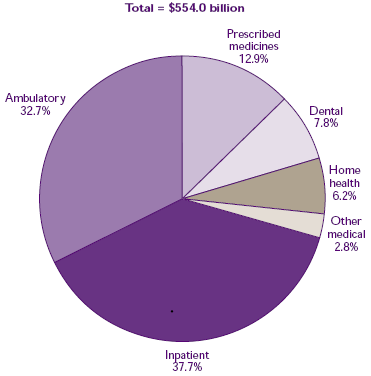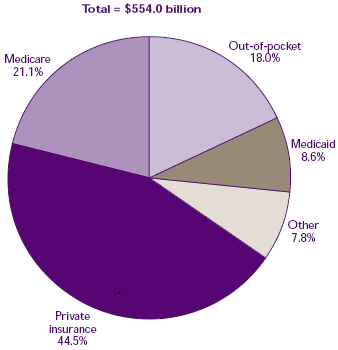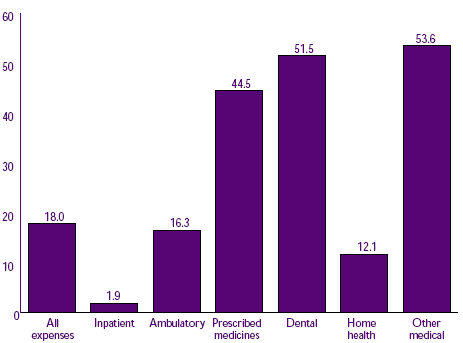Highlights
#11: Distribution of Health Care Expenses, 1996
Estimates for the U.S.
Civilian Noninstitutionalized Population
Introduction
The Medical
Expenditure Panel Survey (MEPS) is the Nation’s primary
source of detailed, nationally representative data on medical
care spending and sources of payment
for the U.S. civilian noninstitutionalized (community) population.
MEPS provides researchers and policymakers with data on how much
is paid for various types of health care services and who pays
for them. This Highlights describes total spending for
medical expenses in 1996, overall and by type of service. Data
are also presented on the proportion of expenses paid by different
sources, including out-of-pocket, Medicare, Medicaid, and private
insurance. Detailed information of this sort has not been available
since data from the 1987 National Medical Expenditure Survey
(NMES) were released in the
early 1990s.
^top
Briefly Stated
- In 1996, about $554 billion in payments
were made for health care services and supplies used by the
U.S. community population.
- Hospital inpatient stays made up the largest
share of national health expenses (38 percent), followed by
ambulatory services from both physician and nonphysician providers
(33 percent).
- Private insurance paid for the largest portion
of national medical expenses.
- Medicare and out-of-pocket spending each
accounted for about 1 of every 5 dollars spent on health care.
^top
Definitions
Expenses in MEPS are defined as the
sum of direct payments for care provided during the year, including
out-of-pocket payments
and payments by private insurance, Medicare, Medicaid, and other
sources. MEPS and the Health Care Financing Administration's National
Health Accounts (NHA) have substantial differences in methodologies
and objectives. In particular, the NHA are based on a composite
of data from multiple sources at the aggregate national level and
are used primarily to track aggregate medical expenditures in the
U.S. economy. In contrast, MEPS collects survey data on individuals
that can be used to estimate direct payments made for medical care
and services purchased by the civilian noninstitutionalized population.
Data from the survey are widely used for behavioral and socioeconomic
analyses of the relationship between individual characteristics
and health care spending.
National health care expenditure estimates from MEPS are lower
than those estimated by the NHA for several reasons. First, the
NHA are more expansive in the scope of included expenditures, including,
for example, expenditures for over-the-counter drugs, nursing home
care, program administration, Government public health activities,
and construction, as well as some hospital and physician revenues
not associated with patient care. Second, the NHA include health
care expenditures for individuals who are not members of the civilian
noninstitutionalized population, such as individuals in the military
and those residing in nursing homes, assisted living facilities,
and prisons. Researchers at the Agency for Healthcare Research
and Quality (AHRQ) and the Health Care Financing Administration
estimate that adjustments for differences in the scope of included
expenditures and population reduce the NHA's national estimate
to $606 billion (versus the corresponding MEPS national estimate
of $554 billion). For the most part, the remaining difference is
likely to reflect some combination of (a) irreconcilable definition
and measurement differences between NHA and MEPS and (b) statistical
uncertainty associated with sampling error (in both MEPS and the
NHA).
Expenses are grouped into six broad types of service:
hospital inpatient, ambulatory, prescribed medicines, dental,
home health,
and other medical. Ambulatory services include office-based care
as well as visits to hospital outpatient departments and emergency
rooms. The "other medical" category includes glasses,
ambulance services, orthopedic items, hearing devices, prostheses,
bathroom aids, medical equipment, disposable supplies, and other
miscellaneous items or services.
Expenses are also grouped into five broad sources of payment:
private health insurance, Medicare, Medicaid, out-of-pocket, and
other. "Other" includes payments from the Department
of Veterans Affairs; Worker's Compensation; nonhealth insurance
sources (such as automobile, homeowner's, and liability insurance);
miscellaneous Federal, State, and local programs; and unknown sources.
^top
Type of Service
In 1996, approximately $554 billion in payments
were made for health care services and supplies used by the largest
component, accounted for nearly 4 of every 10 dollars spent,
followed by ambulatory services, which accounted for about 1
in 3 dollars spent (Figure 1).
Prescribed medicines accounted for 13 percent of the total.
Source of Payment
As shown in Figure
2, private health insurance paid for about 45 percent of
all health care expenses. Medicare and out-of-pocket spending
each accounted for about 2 of every 10 dollars spent (21 and
18 percent, respectively). In combination, these three sources
comprised more than 8 of every 10 dollars spent on health care
during the year. Medicaid (the primary public health insurance
program for the poor and disabled) accounted for the next largest
share of the total (9 percent).
Out-of-Pocket-Spending
Out-of-pocket medical spending varied dramatically
by type of service (Figure 3).
Overall, 18 percent of the dollars spent for medical care in
1996 were paid for out of pocket. However, the proportion of
expenses paid out of pocket was much larger for other medical
expenses (mostly equipment and supplies), 54 percent; dental
care, 52 percent; and prescribed medicines, 45 percent. In contrast,
the out-of-pocket portion was lower than the overall average
for home health services (12 percent) and inpatient hospital
care (2 percent).
^top
About MEPS
MEPS collects nationally
representative data on health care use, expenses, sources of
payment, and insurance coverage for the U.S. civilian noninstitutionalized
population. It is co-sponsored by AHRQ and the National Center
for
Health Statistics (NCHS). This Highlights summarizes data concerning health
care expenses in the United States during 1996, as derived from the MEPS Household
Component, Rounds 1-3. For more information about MEPS, see the sources listed
on the back page.
^top
Figures
Figure 1.
Percent distribution of health expenses, by type of service:
1996

- The largest share of
national health care expenses was for inpatient hospital care,
followed by ambulatory services.
DATA SOURCE: 1996
Medical Expenditure Panel Survey Household Component.
^top
Figure 2. Percent
distribution of health expenses, by source of payment: 1996

- Private health insurance
was by far the largest payer of medical care expenses. Medicare
and out-of-pocket spending were the next largest.
DATA
SOURCE: 1996 Medical Expenditure Panel Survey Household
Component.
^top
Figure 3. Percent
of health expenses paid out of pocket, by type of service:
1996

- "Other Medical" (mostly
supplies and equipment), dental care, and prescribed medicines
were the service categories that had the highest proportion
of expenses paid out of pocket.
DATA
SOURCE: 1996 Medical Expenditure Panel Survey Household
Component.
^top
References
For more information about MEPS, call the MEPS
information coordinator at AHCPR (301-594-1406) or visit the
MEPS section of the AHCPR Web site at: http://www.meps.ahrq.gov
For a detailed description of the MEPS survey
design, sample design, and methods used to minimize sources of
nonsampling error, see the following publications:
Cohen J. Design and methods of the Medical
Expenditure Panel Survey Household Component. Rockville (MD):
Agency for Health Care Policy and Research; 1997. MEPS Methodology
Report No. 1. AHCPR Pub. No. 97-0026.
Cohen S. Sample design of the 1996 Medical
Expenditure Panel Survey Household Component. Rockville (MD):
Agency for Health Care Policy and Research; 1997. MEPS Methodology
Report No. 2. AHCPR Pub. No. 97-0027.
Machlin S, Taylor A. Design, methods, and field
results of the 1996 Medical Expenditure Panel Survey Medical
Provider Component. Rockville (MD): Agency for Healthcare Research
and Quality; 2000. MEPS Methodology Report No. 9. AHRQ Pub. No.
00-0028.
The estimates in this Highlights are
based on the MEPS Expenditure File (HC-011), which is available
on the MEPS Web site. More detailed information on national medical
expenses will be published in:
Cohen JW, Machlin SR, Zuvekas SH, et al. Health
care expenses in the United States, 1996. MEPS Research Findings.
Forthcoming.
MEPS publications are available from the AHRQ
Clearinghouse (800-358-9295) and on the MEPS Web site.
MEPS Highlights No. 11,
AHRQ Pub. No. 00-0024, May 2000.
^top
Suggested Citation:
Highlights #11: Distribution of Health Care Expenses, 1996. May 2000. Agency for Healthcare Research and Quality, Rockville, MD.
http://www.meps.ahrq.gov/data_files/publications/hl11/hl11.shtml
|
|
